Gamification is the strategic application of game design elements in non-game contexts. Business training platforms like GoSkills use gamification to boost employee engagement and motivation. But balance is crucial. Studies highlight the downsides of over-gamification: overly playful themes can clash with corporate culture and detract from serious learning objectives.
LMS gamification
This is why leading LMS platforms (learning management systems) integrate gamification features thoughtfully, creating professional, engaging experiences that achieve learning goals without compromising formality.
Think of a gamified LMS as a fitness tracker for learning. Just as a fitness tracker displays your steps and active minutes, an LMS shows your completed modules, quiz scores, and overall course progress.
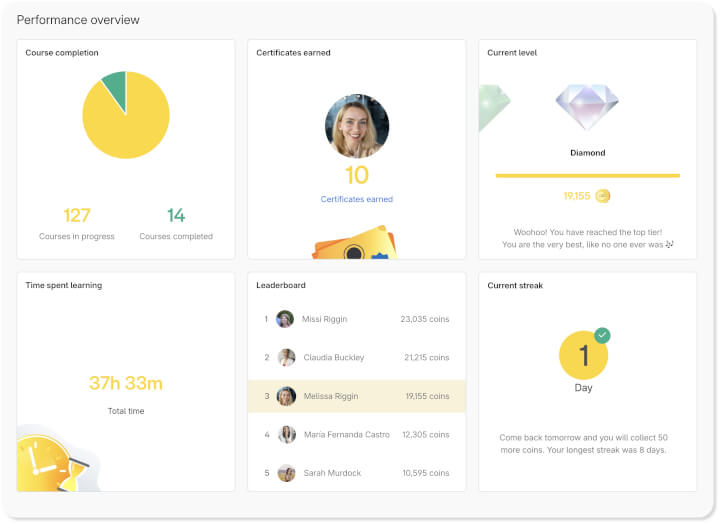
While this approach clearly boosts user engagement, its effectiveness has limits. These underscore the need for thoughtful implementation to achieve the best results.
Key article takeaways
- LMS with gamification definition: Gamification in an LMS strategically applies game elements like points and badges to learning contexts. The point is to boost learner motivation with engaging experiences that improve educational outcomes.
- Overgamification risks for employee training: Over-gamification in corporate settings carries risks such as mismatching corporate culture, diminishing engagement over time due to novelty, and misaligning rewards with actual learning objectives.
- Best LMS with gamification platform examples: Leading business LMS platforms like GoSkills, Docebo, TalentLMS, and EducateMe demonstrate how to effectively integrate gamification for business training. These platforms mitigate risks by balancing engagement with strategic learning objectives.
- GoSkills LMS gamification closeup: GoSkills stands out by offering a toned-down, professionally-oriented gamification approach with features like skill-based points, meaningful badges, and constructive leaderboards. See for yourself how these align with corporate learning goals.
Definition: gamification in online learning
Gamification applies game-like elements and design principles to online learning, transforming educational tasks into engaging interactive experiences. It leverages inherent human desires for achievement and competition, motivating learners through features such as points, badges, leaderboards, and challenges.

The point of these is to boost engagement and improve learning outcomes. Duolingo is the most widely known instance of gamification in online learning. It motivates users through streaks for daily practice, awards XP (Experience Points) and badges for milestones, and uses leaderboards to foster friendly competition among learners.
Common LMS gamification features
To effectively leverage the power of gamification, many modern Learning Management Systems (LMS) integrate similar game-like elements.
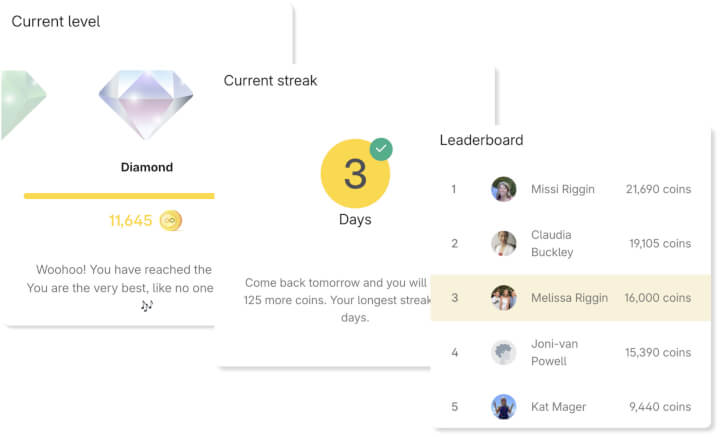
Common gamification features used by business training LMS platforms include:
- Points: Learners earn points for completing modules, quizzes, participating in discussions, or logging in consistently. These points often contribute to their overall score and progress.
- Badges/awards/medals: Digital badges are awarded for achieving specific milestones, completing courses, mastering skills, or demonstrating expertise. They serve as visual recognition of accomplishment.
- Levels/progression: Content is often structured into hierarchical levels (e.g., Novice, Intermediate, Expert). Learners advance to new levels as they complete tasks, accumulate points, or earn badges, creating a clear pathway and sense of progress.
- Leaderboards: These display rankings of learners or teams based on points, course completion, or other metrics, fostering healthy competition and encouraging engagement.
- Progress bars: Visual indicators that show learners how much of a course or module they have completed, providing a sense of achievement and motivating them to continue.
- Quizzes and interactive challenges: Incorporating game-like quizzes, puzzles, and problem-solving scenarios to test knowledge and reinforce learning in an engaging way.
- Rewards/marketplace: Systems where accumulated points can be redeemed for virtual rewards, course discounts, or even tangible incentives, further motivating participation.
- Storytelling/narratives: Creating a compelling storyline or theme for the learning journey that captivates learners and provides context for the training, making it more immersive and memorable.
- Real-time feedback: Immediate feedback on performance in quizzes, tasks, or challenges, allowing learners to understand their progress and areas for improvement instantly.
- Social learning elements: Features that promote collaboration, competition, and social interaction among learners, such as team challenges, discussion forums, and the ability to share achievements.
- Customizable avatars: Allowing learners to create and personalize their own digital representations within the learning environment.
Over-gamification risks in business learning platforms
While a well-designed gamified experience can energize learners, excessive gamification can actually demotivate adult learners and hinder company training goals.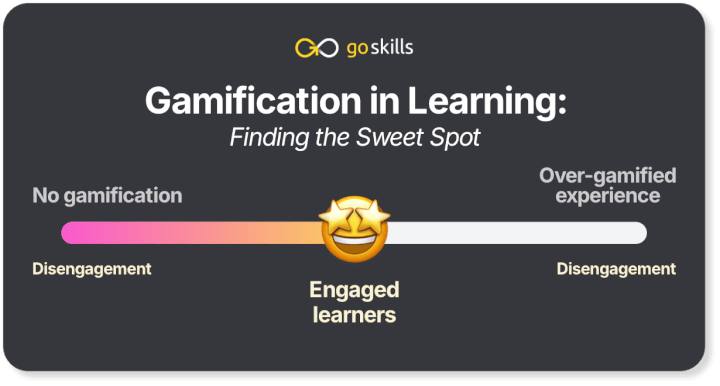
Several studies have touched on the potential pitfalls of too much gamification in business training:
- Mismatch with corporate culture: Duolingo’s overly "gamey" designs may be perceived as unprofessional or trivial, especially for adult learners studying serious corporate topics. As this study shows, if the gamification doesn't align with the company's culture or the seriousness of the content, it can disengage rather than motivate.
- Diminished value over time/novelty effect: According to a study on gamification for mental health, gamification can lead to a "novelty effect," where engagement fades once learners get accustomed to the game mechanics. It can be expensive and time-consuming to continuously update and refresh gamified content to maintain interest.
- Risk of misalignment with learning objectives: A 2024 study showed how the pursuit of points, badges, or leaderboards can overshadow actual learning objectives. Learners might focus on "gaming the system" for rewards rather than genuinely understanding and applying the content.
- Not suitable for all content or learners: Highly sensitive, complex, or serious topics (like compliance, ethics, crisis management) may not be appropriate for a lighthearted gamified approach. Additionally, not all individuals are motivated by competitive or game-like structures; some may find them distracting or even off-putting.
- Over-reliance on extrinsic motivation: If gamification relies too heavily on external rewards (points, badges, prizes), it can undermine learners' intrinsic motivation – their inherent desire to learn for its own sake. Once external rewards lose their appeal, engagement can drop significantly.
Gamified LMS: 5 examples
Having considered the potential pitfalls of over-gamification in business training, it's crucial to recognize that well-designed approaches can successfully mitigate these risks. Most of the top business training LMS platforms use similar gamification techniques.
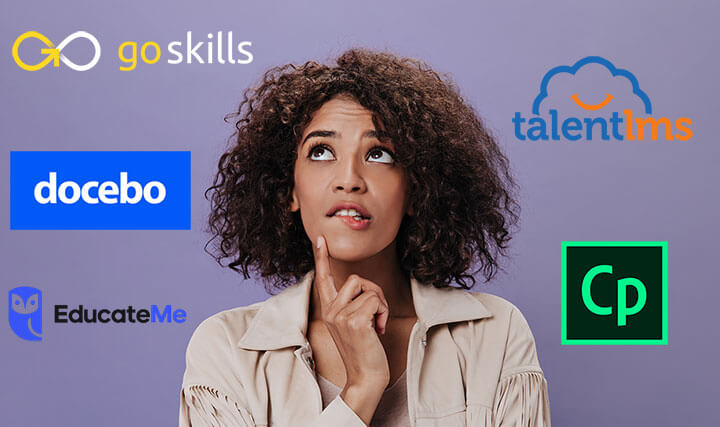
The following listing ranks five of the most polished business gamification approaches I've seen. These platforms thoughtfully integrate meaningful engagement tweaks to enhance professional development and training:
1. GoSkills
Uniquely integrates gamification within a microlearning framework, offering features like time-tracking goals, daily streaks, and personalized rewards. This combination is designed to sustain interest and accelerate learning outcomes by breaking down content into digestible, engaging challenges.
2. Docebo
Stands out with a comprehensive approach that includes points, leaderboards, contests, and an innovative Reward Marketplace. It also offers customized experiences that combine formal, social, and collaborative learning with its gamified elements.
3. TalentLMS
Provides a dynamic gamified experience with progressive point allocation, milestone badges, and a structured skill development leveling system. Its interactive leaderboards and the ability to integrate tangible rewards (like course discounts) further boost learner motivation and retention.
4. EducateMe
Focuses on analytics-driven gamification, allowing instructors to design personalized strategies. It leverages certificates as achievements, implements progression-based learning with bite-sized content and drop scheduling, and offers customizable gamification pages for leaderboards, point systems, and interactive challenges.
5. Adobe Captivate
Encourages consistent learning through points for regular engagement and tasks with specific points allocation. It fosters competition with a leaderboard and incorporates distinct achievement levels (Bronze, Silver, Gold, Platinum), adding a clear progression path for learners.
Gamification features in the GoSkills LMS
Unlike the often overtly playful interfaces seen in consumer apps, GoSkills provides strategically integrated gamification features. These are designed to enhance engagement within professional learning environments.
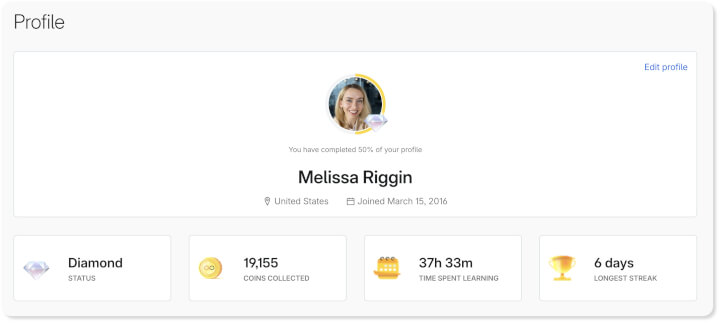
According to GoSkills CEO Bhav Chahal, the LMS first started integrating gamification elements in 2013, after testing gamified features with client partners.
The feedback we received was consistent with the studies: clients want balanced gamification features that engage without distracting.
— Bhavneet Chahal, GoSkills co-founder
That vision has persisted. In 2025, GoSkills continues to deliver a sophisticated, yet motivating, approach that respects corporate formality — while still driving learner achievement.
Points System
The GoSkills points system is designed to align with professional development goals. Learners earn points for tangible achievements like completing courses, passing quizzes, and mastering new skills.
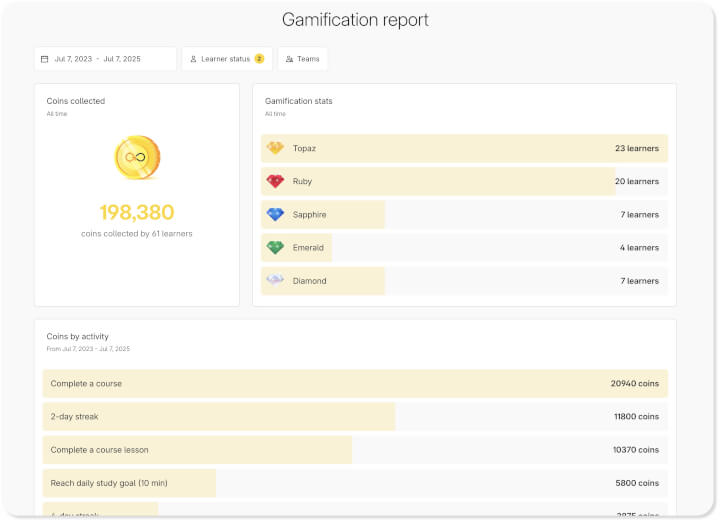
This system provides clear, measurable feedback on progress, serving as a professional metric for effort and engagement. Points contribute to structured rewards and recognition, fostering a goal-oriented mindset.
Gem badges
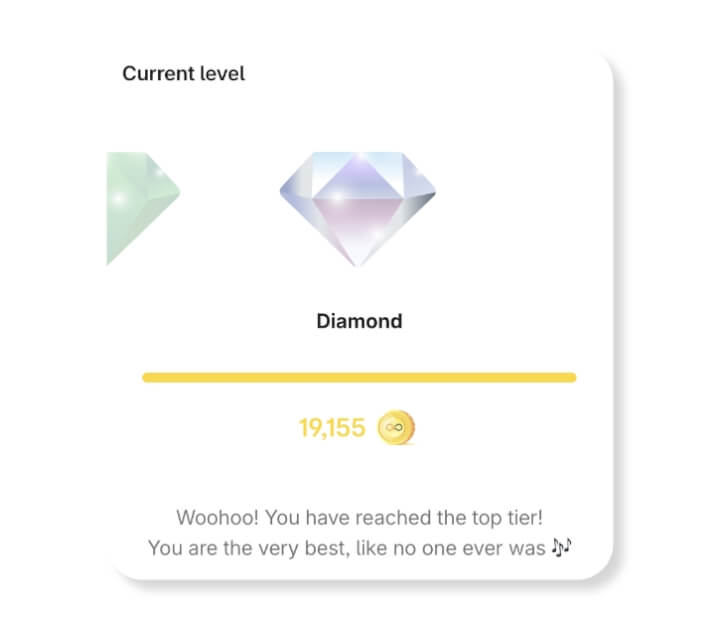
GoSkills leverages gems as meaningful recognition of professional accomplishment. Earned through a mastery of learning objectives, these signify tangible skill acquisition and course completion. These reinforce the value of continuous learning and provide concrete motivation for career advancement.
Leaderboards
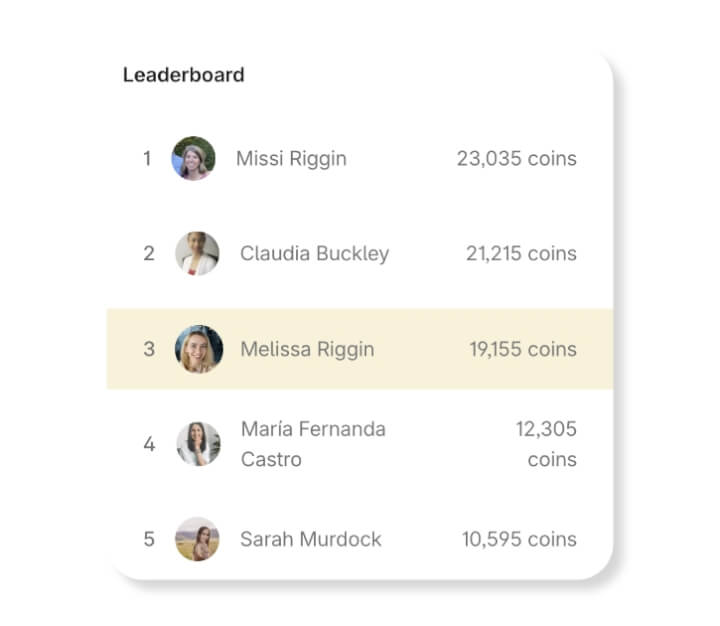
GoSkills leaderboards foster constructive competition and peer benchmarking within a professional context. They transparently display top performers based on earned points and completed achievements, motivating individuals to enhance their skills and performance.
Progress Tracking
GoSkills offers learners a clear, objective overview of their professional development journey. Users can easily monitor their advancement through courses and skill acquisition, providing continuous motivation by highlighting completed work and remaining objectives.
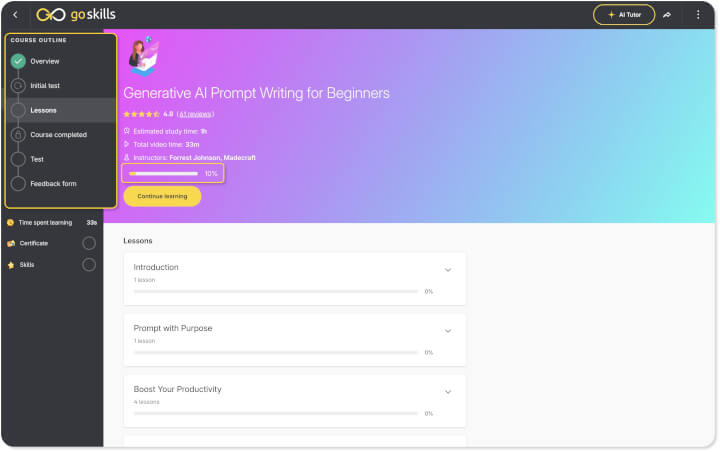
GoSkills users can track progress using the left sidebar or the header progress bar within any course. This transparent tracking also serves as a valuable tool for instructors and managers, enabling them to assess performance, identify areas for support, and provide targeted coaching to ensure individual and team success.
📚 Related: Gamification Help Center For GoSkills LMS Customers
LMS with gamification FAQs
-
How does gamification boost engagement in an LMS?
Gamification transforms engagement by applying game-like elements (points, badges, challenges) to learning tasks, turning traditional training into interactive and motivating experiences.
This taps into natural human desires for achievement and competition, making learning feel less like a chore and more like an engaging journey.
-
Does a gamified LMS objectively boost learning outcomes?
Gamification can boost learning outcomes, motivation, and engagement—but context and design are crucial. The strongest evidence supports effects on cognitive learning, though motivation and behavior can vary. Poor design choices—especially over‑reliance on extrinsic rewards or neglecting individual learner differences—can negate positive effects or even harm learning. Consider these studies:
| Category | Effectiveness Summary | Source |
|---|---|---|
| Cognitive outcomes | Consistently small-to-moderate benefit (g ≈ 0.49) in rigorous studies | Sailer & Homner, 2020 – Educational Psychology Review (Springer) |
| Motivation & behavior | Positive but less stable effects, moderated by design elements like narrative and social interaction | Sailer & Homner, 2020 |
| Overall learning | When aggregated across studies, strong positive effect (g ≈ 0.82) | Li et al., 2023 – Frontiers in Psychology |
| Design matters | Game fiction, social features, competition + collaboration, duration, and learner profile significantly affect outcomes | Sailer & Homner, 2020 |
| Risks / drawbacks | Overemphasis on badges/leaderboards can demotivate, distract, or reduce performance—especially in extrinsic setups | Almeida et al., 2023 – arXiv Mogavi et al., 2022 – arXiv Domínguez et al., 2013 – Computers & Education |
| Temporal effects | Initial novelty can boost engagement, but effects may dip and then rebound | Sailer & Homner, 2020 |
-
What are the risks of over-gamification in business learning environments?
Risks include a mismatch with corporate culture (e.g., overly childish designs for serious topics), the "novelty effect" wearing off, potential misalignment where learners focus on "gaming the system" rather than genuine learning, and the risk of undermining intrinsic motivation if external rewards become the sole focus.
-
How to implement gamification within a business LMS?
If you're implementing gamification, ensure:
- A solid theoretical foundation (e.g., intrinsic motivation, social dynamics)
- Thoughtful inclusion of narrative and social elements
- Balanced and adaptable design to prevent overjustification
- Ongoing monitoring & adjustment based on learner response
-
What are some key gamification trends in elearning?
A systematic literature review of gamification in elearning was compiled in 2023. Key findings:
- The most common elements used include points, badges, and leaderboards.
- More platforms are introducing deeper elements like challenges or storytelling narratives.
- Gamification in higher ed is growing post-COVID due to increased digital instruction and student disengagement.
- Machine learning approaches are emerging as tools to drive adaptive gamification.
- Most design efforts are not theory-driven: There is a disconnect between theoretical models and practical implementation.
Conclusion: Leveraging an LMS with gamification to upskill business teams
Platforms like GoSkills exemplify how gamification can be strategically integrated within corporate learning environments, offering a refined approach that supports professional development without sacrificing formality.
By carefully selecting and implementing an LMS with gamification that aligns with specific organizational goals and learner needs, businesses can unlock unparalleled levels of engagement, retention, and ultimately, significantly enhance their teams' capabilities and achieve superior training outcomes.
How to use gamification in your business
Get inspired by the success of O’Brien Fine Foods’ training program.
Experience the difference
Explore the GoSkills LMS — no credit card required. Get started in minutes!
Create your free account



